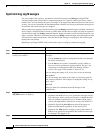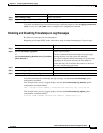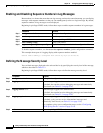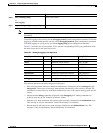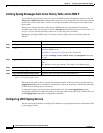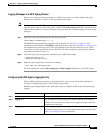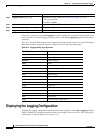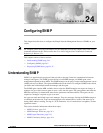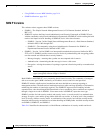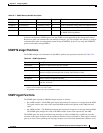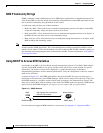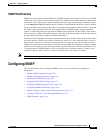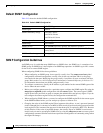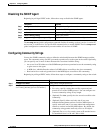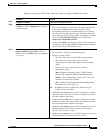
24-2
Catalyst 2950 Desktop Switch Software Configuration Guide
78-14982-01
Chapter 24 Configuring SNMP
Understanding SNMP
• Using SNMP to Access MIB Variables, page 24-4
• SNMP Notifications, page 24-5
SNMP Versions
This software release supports these SNMP versions:
• SNMPv1—The Simple Network Management Protocol, a Full Internet Standard, defined in
RFC 1157.
• SNMPv2C replaces the Party-based Administrative and Security Framework of SNMPv2Classic
with the community-string-based Administrative Framework of SNMPv2C while retaining the bulk
retrieval and improved error handling of SNMPv2Classic. It has these features:
–
SNMPv2—Version 2 of the Simple Network Management Protocol, a Draft Internet Standard,
defined in RFCs 1902 through 1907.
–
SNMPv2C—The community-string-based Administrative Framework for SNMPv2, an
Experimental Internet Protocol defined in RFC 1901.
• SNMPv3—Version 3 of the SNMP is an interoperable standards-based protocol defined in RFCs
2273 to 2275. SNMPv3 provides secure access to devices by authenticating and encrypting packets
over the network and includes these security features:
–
Message integrity—ensuring that a packet was not tampered with in transit
–
Authentication—determining that the message is from a valid source
–
Encryption—mixing the contents of a package to prevent it from being read by an unauthorized
source.
Note To select encryption, enter the priv keyword. This keyword is available only when the
crypto (encrypted) software image is installed.
Both SNMPv1 and SNMPv2C use a community-based form of security. The community of managers
able to access the agent’s MIB is defined by an IP address access control list and password.
SNMPv2C includes a bulk retrieval mechanism and more detailed error message reporting to
management stations. The bulk retrieval mechanism retrieves tables and large quantities of information,
minimizing the number of round-trips required. The SNMPv2C improved error-handling includes
expanded error codes that distinguish different kinds of error conditions; these conditions are reported
through a single error code in SNMPv1. Error return codes in SNMPv2C report the error type.
SNMPv3 provides for both security models and security levels. A security model is an authentication
strategy set up for a user and the group within which the user resides. A security level is the permitted
level of security within a security model. A combination of the security level and the security model
determine which security mechanism is used when handling an SNMP packet. Available security models
are SNMPv1, SNMPv2C, and SNMPv3.
Table 24-1 identifies the characteristics of the different combinations of security models and levels.



